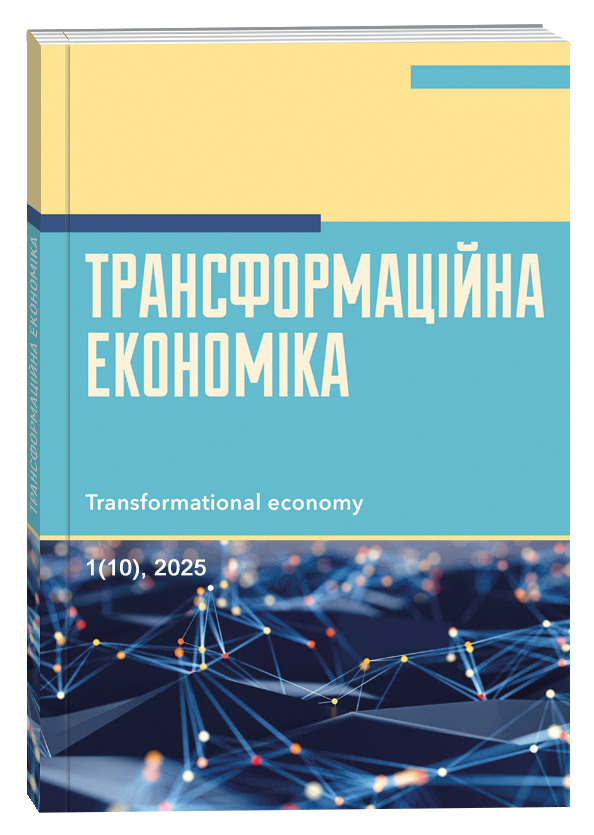MODEL IMPACT OF ECONOMIC ASYMMETRIES ON THE DEVELOPMENT OF GLOBAL INDUSTRIAL GIANTS
Abstract
The study emphasizes that economic asymmetries arise not only due to the uneven distribution of economic resources among countries, regions, or sectors but also due to a range of other factors, including unequal access to natural resources, differences in the level of technological development, limited financial capabilities, uneven infrastructure development, and more. At the same time, these factors have a polarizing effect on the development of global industrial giants, creating both obstacles and favorable conditions for their dominance in international markets, accelerating or decelerating growth, and leading to either concentration or dispersion of capital. Thus, understanding the specific impact of economic asymmetries on the development of global industrial giants is crucial from both an operational and strategic perspective, as it enables analysis of how the distribution of resources, technologies, infrastructure, investments, and other factors influences current and future profits. The aim of the study is to identify the specific features of analyzing the impact of economic asymmetries on the development of global industrial giants by modeling the key factors that determine the uneven distribution of resources, market opportunities, and regulatory constraints. The study results demonstrate that the impact of economic asymmetries on the development of global industrial giants is determined by the advantages they gain from leveraging the unevenness or imbalance in the distribution of economic resources, opportunities, and outcomes across countries, regions, and sectors. It has been proven that economic asymmetries contribute to: reducing extraction costs through the benefits of resource monopolization, optimizing production scales, accessing financial and technological resources, and lowering production costs due to insufficient regulation. It has been proven that the impact of economic asymmetries on the development of global industrial giants can be modeled using a multiple regression equation. This approach allows for: evaluating the utilization of unevenness or imbalances in favor of corporations, which shape the outcome indicator (Y) manifested as superprofits; accounting for the interaction between elements of unevenness or imbalances, including complex cause-and-effect relationships that can be quantitatively assessed.
References
Asymmetry. Merriam-Webster.com Dictionary. Available at: https://www.merriam-webster.com/dictionary/asymmetry
Balezhentis A., Yatsenko O. (2018) Asymetriyi torhovelʹnoyi intehratsiyi Ukrayiny ta YES [Asymmetries of trade integration between Ukraine and the EU]. Mizhnarodna ekonomichna polityka – International Economic Policy, vol. 1 (28), pp. 32–62.
Duhinetsʹ H. V. (2019) Informatsiyna asymetriya u svitoviy ekonomitsi [nformation asymmetry in the world economy]. Ekonomichnyy prostir – Economic Space, vol. 150, pp. 25–29.
Kravchuk N. Ya. (2011) Asymetriyi i dysbalansy hlobalʹnoho rozvytku: ideyno-teoretychni ta fundamentalʹni osnovy [Asymmetries and imbalances of global development: ideological, theoretical and fundamental foundations]. Mizhnarodna ekonomichna polityka – International Economic Policy, vol. 1–2, pp. 170–210.
Krugman P., Obstfeld M., Melitz M. (2014) International Economics: Theory and Policy. 10th ed. Pearson Education, 792 p.
Hadjiyiannis C. (2004) Regionalism and Multilateral Trade Liberalization with Asymmetric Countries. Review of International Economics, vol. 12, issue 3, pp. 395–411.
Rudych O. O., Herasymenko I. O., Tkachenko K. V. (2016) Sutnistʹ ekonomichnoyi stiykosti pidpryyemstva ta protses yiyi zabezpechennya [The essence of economic sustainability of enterprises and the process of its provision]. Innovatsiyna ekonomika – Innovative Economics, vol. 11-12, pp. 74–76.
Asymmetry. Merriam-Webster.com Dictionary. URL: https://www.merriam-webster.com/dictionary/asymmetry
Балежентіс А., Яценко О. Асиметрії торговельної інтеграції України та ЄС. Міжнародна економічна політика. 2018. № 1 (28). С. 32–62.
Дугінець Г. В. Інформаційна асиметрія в світовій економіці. Економічний простір. 2019. № 150. С. 25–29.
Кравчук Н. Я. Асиметрії і дисбаланси глобального розвитку: ідейно-теоретичні та фундаментальні основи. Міжнародна економічна політика. 2011. № 1–2. С. 170–210.
Krugman P., Obstfeld M., Melitz M. International Economics: Theory and Policy. 10th edition. Pearson Education, 2014. 792 p.
Hadjiyiannis C. Regionalism and Multilateral Trade Liberalization with Asymmetric Countries. Review of International Economics. 2004. Vol. 12. Issue 3. P. 395–411.
Рудич О. О., Герасименко І. О., Ткаченко К. В. Сутність економічної стійкості підприємств та процесу її забезпечення. Інноваційна економіка. 2016. № 11-12. С. 74–76.


